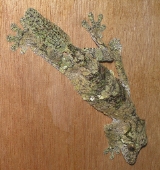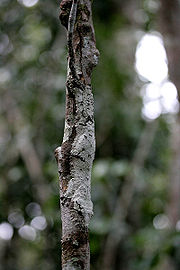
Uroplatus sikorae
Encyclopedia


Species
In biology, a species is one of the basic units of biological classification and a taxonomic rank. A species is often defined as a group of organisms capable of interbreeding and producing fertile offspring. While in many cases this definition is adequate, more precise or differing measures are...
of gecko
Gecko
Geckos are lizards belonging to the infraorder Gekkota, found in warm climates throughout the world. They range from 1.6 cm to 60 cm....
commonly referred to as the Mossy leaf-tailed gecko. This species, endemic to Madagascar, is found in primary
Old growth forest
An old-growth forest is a forest that has attained great age , and thereby exhibits unique ecological features. An old growth forest has also usually reached a climax community...
and secondary
Secondary forest
A secondary forest is a forest or woodland area which has re-grown after a major disturbance such as fire, insect infestation, timber harvest or windthrow, until a long enough period has passed so that the effects of the disturbance are no longer evident...
forests on the island. It has the ability to change its skin color to match its surroundings and possesses dermal flaps which break up its outline when at rest.
It is a CITES II protected animal due to habitat loss and overcollection for the pet trade.
Taxonomy and etymology
The genericGenus
In biology, a genus is a low-level taxonomic rank used in the biological classification of living and fossil organisms, which is an example of definition by genus and differentia...
name, Uroplatus
Uroplatus
Uroplatus is a genus of geckos commonly referred to as Flat or Leaf-tailed Geckos. All the comprising species are endemic to Madagascar or nearby islands, such as Nosy Be, where they are found in primary and secondary forests.-Etymology:...
, is a Latinization
Latin
Latin is an Italic language originally spoken in Latium and Ancient Rome. It, along with most European languages, is a descendant of the ancient Proto-Indo-European language. Although it is considered a dead language, a number of scholars and members of the Christian clergy speak it fluently, and...
of two Greek
Ancient Greek
Ancient Greek is the stage of the Greek language in the periods spanning the times c. 9th–6th centuries BC, , c. 5th–4th centuries BC , and the c. 3rd century BC – 6th century AD of ancient Greece and the ancient world; being predated in the 2nd millennium BC by Mycenaean Greek...
words: "ourá" (οὐρά) meaning "tail" and "platys" (πλατύς) meaning "flat". Its specific name is a Latinization of the name Franz Sikora, a German
Germany
Germany , officially the Federal Republic of Germany , is a federal parliamentary republic in Europe. The country consists of 16 states while the capital and largest city is Berlin. Germany covers an area of 357,021 km2 and has a largely temperate seasonal climate...
fossil-hunter and explorer of Madagascar. The species was first described by German zoologist Oskar Boettger
Oskar Boettger
Oskar Boettger was a German zoologist who was a native of Frankfurt am Main. He was an uncle of the noted malacologist Caesar Rudolf Boettger ....
but not published until three years after his death. Its common name refers to the mossy-like camouflage patterns and colors of the lizard's skin.
The genus Uroplatus contains 12 species endemic to Madagascar
Madagascar
The Republic of Madagascar is an island country located in the Indian Ocean off the southeastern coast of Africa...
; Uroplatus sikorae is the only species within this genus containing a subspecies: Sameit's Leaf-tailed gecko Uroplatus sikorae sameiti, named for Joachim Sameit. This subspecies was identified in 1990, the chief identifier is the inside of its mouth is pink as opposed to the black coloration of the parent species.
Phylogenically it has been placed within a monophyletic complex consisting of three other species of Uroplatus: U. fimbriatus
Uroplatus fimbriatus
Uroplatus fimbriatus is a gecko which is found in eastern Madagascar and on the islands Nosy Bohara and Nosy Mangabe. These geckos live in tropical rain forests. They reach a total length of 330 mm....
, U. giganteus, U. henkeli
Uroplatus henkeli
Henkel's Leaf-tailed Gecko , is a gecko that is found on the island Nosy Bé near Madagascar, as well as on the mainland Madagascar itself, in the region of Ankaranafantsika. These geckos live an arboreal lifestyle, often venturing down to the ground only to lay eggs in soft soil and leaflitter...
. This complex represents the larger species of the genus.
Description
Mossy leaf-tailed geckos are nocturnal and arboreal. Their eyes are large, lidless, and have yellow scleraSclera
The sclera , also known as the white or white of the eye, is the opaque , fibrous, protective, outer layer of the eye containing collagen and elastic fiber. In the development of the embryo, the sclera is derived from the neural crest...
with elliptical pupils, suited for the gecko's nocturnal habits. The mossy leaf-tailed gecko ranges in size from 6 to 8 in (15.2 to 20.3 cm) when measured from nose to base of the tail. They spend most of the daylight hours hanging vertically on tree trunks, head down, resting. During the night, they will venture from their daylight resting spots, and go off in search of prey.
As with all Uroplatus geckos, the tail is flattened and leaf-like. U. sikorae has coloration developed as camouflage
Camouflage
Camouflage is a method of concealment that allows an otherwise visible animal, military vehicle, or other object to remain unnoticed, by blending with its environment. Examples include a leopard's spotted coat, the battledress of a modern soldier and a leaf-mimic butterfly...
, most being grayish brown to black or greenish brown with various markings meant to resemble tree
Tree
A tree is a perennial woody plant. It is most often defined as a woody plant that has many secondary branches supported clear of the ground on a single main stem or trunk with clear apical dominance. A minimum height specification at maturity is cited by some authors, varying from 3 m to...
bark; down to the lichens and moss found on the bark. U. sikorae has flaps of skin, running the length of its body, head and limbs, known as the dermal flap, which it can lay against the tree during the day, scattering shadows, and making its outline practically invisible. Additionally, the gecko can change its skin color to match its background similar to the chameleon
Chameleon
Chameleons are a distinctive and highly specialized clade of lizards. They are distinguished by their parrot-like zygodactylous feet, their separately mobile and stereoscopic eyes, their very long, highly modified, and rapidly extrudable tongues, their swaying gait, the possession by many of a...
s of Madagascar.
Distribution and habitat
Uroplatus sikorae are endemic to MadagascarMadagascar
The Republic of Madagascar is an island country located in the Indian Ocean off the southeastern coast of Africa...
and are found nowhere else. These geckos are an arboreal species relying on their natural camouflage
Camouflage
Camouflage is a method of concealment that allows an otherwise visible animal, military vehicle, or other object to remain unnoticed, by blending with its environment. Examples include a leopard's spotted coat, the battledress of a modern soldier and a leaf-mimic butterfly...
as they dwell among the trees of the Eastern and central tropical forests of Madagascar.
Captivity
The mossy leaf-tailed gecko is uncommon in captivity and often kept in breeding pairs or trios. They eat a variety of appropriately sized insectInsect
Insects are a class of living creatures within the arthropods that have a chitinous exoskeleton, a three-part body , three pairs of jointed legs, compound eyes, and two antennae...
s including crickets
Cricket (insect)
Crickets, family Gryllidae , are insects somewhat related to grasshoppers, and more closely related to katydids or bush crickets . They have somewhat flattened bodies and long antennae. There are about 900 species of crickets...
and moth
Moth
A moth is an insect closely related to the butterfly, both being of the order Lepidoptera. Moths form the majority of this order; there are thought to be 150,000 to 250,000 different species of moth , with thousands of species yet to be described...
s. If breeding is successful in captivity, eggs will be laid every 30 days and take 90 days to hatch.
Threats
Habitat destruction and deforestation in Madagascar is the primary threat to this animal's future as well as collection for the pet trade. The World Wide Fund for NatureWorld Wide Fund for Nature
The World Wide Fund for Nature is an international non-governmental organization working on issues regarding the conservation, research and restoration of the environment, formerly named the World Wildlife Fund, which remains its official name in Canada and the United States...
(WWF) lists all of the Uroplatus species on their "Top ten most wanted species list" of animals threatened by illegal wildlife trade
Wildlife trade
The international wildlife trade is a serious conservation problem, addressed by the United Nations' Convention of International Trade in Endangered Species of Wild Fauna and Flora CITES, which currently has 175 member countries called Parties. The 15th meeting of the Parties took place in Doha,...
, because of it "being captured and sold at alarming rates for the international pet trade". It is a CITES Appendix 2 protected animal.

